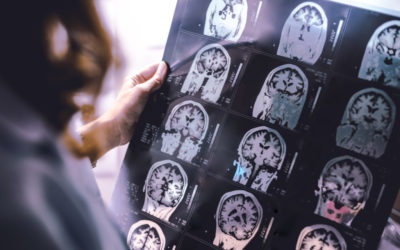
Near-death experiences have fascinated many people ever since they have been reported. And these experiences guide our view of how we die: the memories of your life passing in front of your eyes, the tunnel of light, the floating movement towards a bright light.
However, this has been difficult to research. The nature of being near to death, or briefly dead, means different things may happen in the brain that can cause hallucinations. For example, Olaf Blanke showed that out of body experiences can be induced in healthy individuals by activating and deactivating different parts of the brain.
Enter this case whereby a team of researchers around Dr. Ajmal Zemmar, a neurosurgeon based at the University of Louisville, actually managed to get EEG recordings of a person as they died.
No this was not a bizarre experiment, which is difficult to run, and would have many moral implications. They had wired up this 87 year-old who was having a severe epileptic seizure, which could be fatal, to try and see what was happening — however this individual had a DNR (do not resuscitate) status and after consulting with the family the patient passed away. This provided the only known example of a person with a quality EEG recording during death.
Obviously, it is a case of only one person who has just had a major epileptic seizure but provides the first glimpse of what is happening in the brain during death. So, you may want to know whether your life’s memories pass in front of your eyes?
Well, they did see a spike in gamma brain wave activity, and gamma waves are also associated with memory recall, shortly before death. However, a gamma spike could also mean many other things. They also noticed enhanced neuronal coherence and coupling — basically showing coordinated activity across the brain.
This case study of one person is therefore interesting, but as a population of one, difficult to draw any conclusions. However, it is a start to get the neural signature of death. What they did note however, is that death is not a sudden thing but much more drawn out than you might expect with cells and processes shutting down over minutes, and hours.
On the same topic another group of researchers around Sam Parnia have also issued a position statement on death and also near-death experiences — this summarises the research but also calls for more structured research around this to pull together these strands of evidence and give greater clarity as to how and in what form death happens and the experiences that accompany this — including those near-death experiences.
I’ll certainly be watching this space with interest.
References:
Vicente Raul, Rizzuto Michael, Sarica Can, et al.
Enhanced Interplay of Neuronal Coherence and Coupling in the Dying Human Brain
Frontiers in Aging Neuroscience: 14; 2022
DOI=10.3389/fnagi.2022.813531
Sam Parnia, Stephen G. Post, Matthew T. Lee, et al.
Guidelines and standards for the study of death and recalled experiences of death — a multidisciplinary consensus statement and proposed future directions.
Annals of the New York Academy of Sciences, 2022
DOI: 10.1111/nyas.14740
More Quick Hits
How Gratitude between Co-Workers Lowers Stress and Increases Performance
Quick HitsDaily brief research updates from the cognitive sciences ratitude is a nice thing to have, I think we all agree on that. But when it comes to the workplace some may see it is just being nice, and not being focused enough on the hard...
Brain Scans Can Predict Your Political Affiliation
Quick HitsDaily brief research updates from the cognitive sciences rain scanning of political partisans is not new and it has long been reported that brain scans can predict political affiliation. But those studies were scans of political partisans...
Children with Same-Sex Parents Are Socially Well-Adjusted
Quick HitDaily brief research updates from the cognitive sciences his is not the first study to report that children of same-sex parents are well adjusted, there are plenty, but it is one of the first to be representative and hence gives some...
Simple Exposure to New Things Makes Your Brain Ready to Learn
ouldn’t it be great if we could learn things with no effort? Well, actually we often do, and children learn vast quantities of information, and knowledge with little to no effort – think of how well we learn languages which become fiendishly...
So, Can Cranberries Improve Memory?
tend to be hesitant to report on studies of single foods doing amazing things (because many do), but this piece of research still caught my eye. So, what did this group of researchers from the University of East Anglia find? Well, they...
The Real Problem with Social Media: It Induces Dissociative States
Quick HitsDaily brief research updates from the cognitive sciences ocial media seems to hijack our brains – or at least according to popular narratives. Most of us have experienced this where you get stuck in an endless stream of content,...
Adventurous Play Boosts Mental Resilience in Kids
o, a simple cheap way to help your kids improve all life skills and strengthen mental wellbeing. Too good to be true? Well, this piece of research, just out, finds a fascinating correlation with mental health and kids. This correlation was...
So, Meditation Doesn’t Change Your Brain – Or Does It?
editation can actually change your brain. "Oh, no it can’t!" say these researchers. "Oh, yes it can!" say a lot of other researchers. Does this start to sound confusing? Well, it does because there has been plenty of evidence that...
The Life Factors that Make Lonely People Lonely
Quick HitsDaily brief research updates from the cognitive sciences ou may assume, logically at first glance, that not having contact to people is the most important factor in loneliness. And obviously this does have a large impact — but...
How Music Helps With Collective Grief
his study recently out analyses a fascinating episode in China at the start of the pandemic. A group of international musicians in Shenzhen produced a viral hit in China. This was a cover version of Michael Jackson's “you are not alone”...










